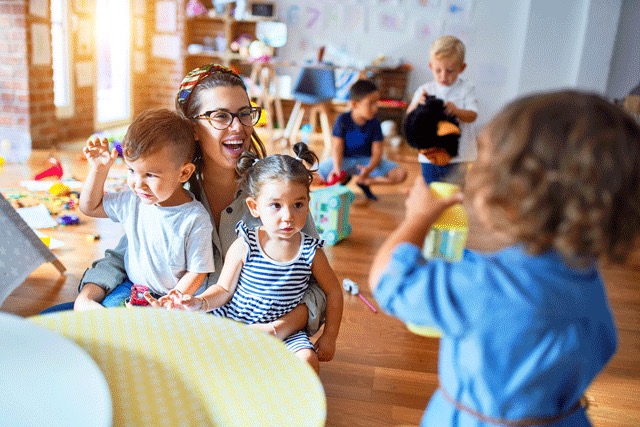When we think about young children learning to read, we might imagine children learning letter names, sight words, and exploring picture books. To become skillful readers and writers, children also need opportunities to build oral or spoken language skills in addition to these important opportunities to engage with printed words.
Oral language skills grow through listening and engaging in conversation with peers and caregivers. During these times, young children explore words, phrases, and the meaning of language. Through conversations and stories, children build vocabulary, reason, and make meaning of their world. In these moments, they are also building knowledge about the sounds and structures of language that are important for reading and writing.
Let’s take a moment to think back to how children explore language first as infants and toddlers. You might remember listening to a child coo and babble. First “ooh” and “ahh,” which eventually changed to “ma ma” and “ba ba.” You heard them repeating and playing with the sounds of language they heard around them. As children move into the preschool years, their oral language becomes more recognizable.
As children are learning to use language to express meaning, they become familiar with the sounds that make up language. Exploring the sounds of language is an important part of learning how to read and write. As children explore, they build phonemic awareness skills. Phonemic awareness is the ability to notice, think about, and work with the individual sounds in spoken words. All of these words that children learn are made up of sounds, or phonemes. Phonemes are the units of sound in language. Each b, p, or eh you hear is a single phoneme. These phonemes are blended together to form words.
Most words are made of more than one phoneme. For example, the word cat is made up of three individual phonemes: K-a-t. Each phoneme can be shown by one or more graphemes. Graphemes in English are single letters or combinations of letters. When children are learning to read and write, they need to make connections between the letters they see and the sounds that they hear.
You might hear children playing with the sounds of language making up silly words, songs, and rhymes. This type of language play is important for learning to read and write. During daily routines, there are many opportunities to explore the sounds of language. The IEL project has a new tip sheet that can provides examples of how to help children learn by listening to language (Learning by Listening to Language). These games will help your child develop an understanding of how spoken words, syllables, and sounds become printed words.
Get started by looking around you for printed words on signs. Talk about the names of people or pets around you. Talk aloud and stretch out the sounds in these words. Ask your child to guess the letter with which names or familiar words start or end. Make up silly rhymes, songs, or chants. Each time you do this, you are helping children develop skills for breaking down words when they read and building words when they write.

Rebecca Swartz
Dr. Rebecca Swartz is an assistant professor in the Department of Teaching and Learning at Southern Illinois University Edwardsville. She teaches courses in the early childhood education program including courses on early language and literacy, early mathematics, and collaboration with families. Prior to coming to SIUE she was an early learning specialist on state early childhood projects in the Department of Special Education at the University of Illinois at Urbana-Champaign.
Biography current as of 2022
IEL Resources
- Tip Sheet: Learning by Listening to Language
- Resource List: Phonological Awareness in Young Children


